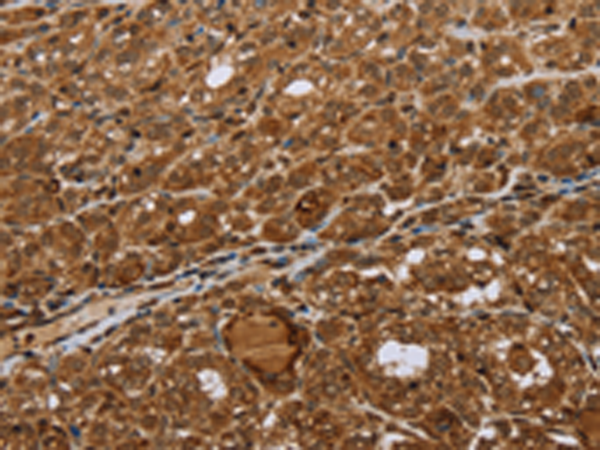


| WB | 咨询技术 | Human,Mouse,Rat |
| IF | 咨询技术 | Human,Mouse,Rat |
| IHC | 1/50-1/200 | Human,Mouse,Rat |
| ICC | 技术咨询 | Human,Mouse,Rat |
| FCM | 咨询技术 | Human,Mouse,Rat |
| Elisa | 1/1000-1/5000 | Human,Mouse,Rat |
| Aliases | SCG10, SCGN10; SCLIP; RB3 |
| WB Predicted band size | 21 kDa |
| Host/Isotype | Rabbit IgG |
| Antibody Type | Primary antibody |
| Storage | Store at 4°C short term. Aliquot and store at -20°C long term. Avoid freeze/thaw cycles. |
| Species Reactivity | Human, Mouse |
| Immunogen | Synthetic peptide of human STMN2/STMN3/STMN4 |
| Formulation | Purified antibody in PBS with 0.05% sodium azide and 50% glycerol. |
+ +
以下是关于STMN2、STMN3和STMN4抗体的3篇参考文献的简要概括(基于公开研究整理):
---
1. **文献名称**: *"Stathmin-2 (STMN2) promotes axonal regeneration in the injured nervous system"*
**作者**: Shin et al.
**摘要**: 本研究利用特异性抗STMN2抗体(SCG10)探究其在轴突再生中的作用。通过免疫组化和Western blot分析,发现STMN2在周围神经损伤后显著上调,并通过调节微管动态促进神经再生。
---
2. **文献名称**: *"STMN3 modulates cancer cell migration via interaction with microtubules"*
**作者**: Belletti et al.
**摘要**: 研究者通过抗STMN3抗体验证其在多种癌细胞系中的表达,发现STMN3通过稳定微管结构增强细胞迁移能力,抗体特异性通过siRNA敲降实验验证,提示其作为癌症治疗靶点的潜力。
---
3. **文献名称**: *"Stathmin-4 (STMN4) regulates neuronal differentiation through RhoA signaling"*
**作者**: Gavet et al.
**摘要**: 使用抗STMN4抗体研究其在神经分化中的作用,发现STMN4通过调控RhoA信号通路影响神经元形态发生。抗体特异性在敲除模型中验证,支持STMN4作为神经发育关键分子的结论。
---
**备注**:若需具体文献全文或实验细节,建议通过PubMed或Sci-Hub输入标题/作者检索获取原文。部分研究可能需结合抗体品牌(如CST、Abcam)官网提供的验证数据辅助引用。
Stathmin (STMN) family proteins, including STMN2 (SCG10), STMN3 (SCLIP), and STMN4 (RB3), are microtubule-destabilizing phosphoproteins involved in regulating cytoskeletal dynamics. They share a conserved stathmin-like domain that binds tubulin heterodimers, promoting microtubule disassembly during cell cycle progression, neuronal development, and signal transduction. STMN2 is predominantly expressed in neuronal tissues, where it localizes to synaptic vesicles and regulates axonal growth and synaptic plasticity. Its dysregulation is linked to neurodegenerative disorders like Alzheimer’s disease. STMN3 shows overlapping functions with STMN2 but exhibits distinct expression patterns, particularly in sensory neurons, and may influence nociception. STMN4. though less studied, is broadly expressed in the brain and interacts with tubulin to modulate microtubule stability during neurogenesis.
Antibodies targeting STMN2/3/4 are essential tools for studying their roles in health and disease. These antibodies are widely used in techniques like Western blotting, immunohistochemistry, and immunofluorescence to map protein expression, subcellular localization, and post-translational modifications (e.g., phosphorylation at serine residues, which regulates activity). Commercially available antibodies vary in specificity; some recognize conserved regions across family members, while others target unique epitopes. Challenges include distinguishing between isoforms due to sequence homology and detecting low-abundance proteins in tissue samples. Validated antibodies have facilitated discoveries in neurobiology (e.g., axon regeneration mechanisms) and oncology, where STMN overexpression correlates with cancer aggressiveness and drug resistance.
×